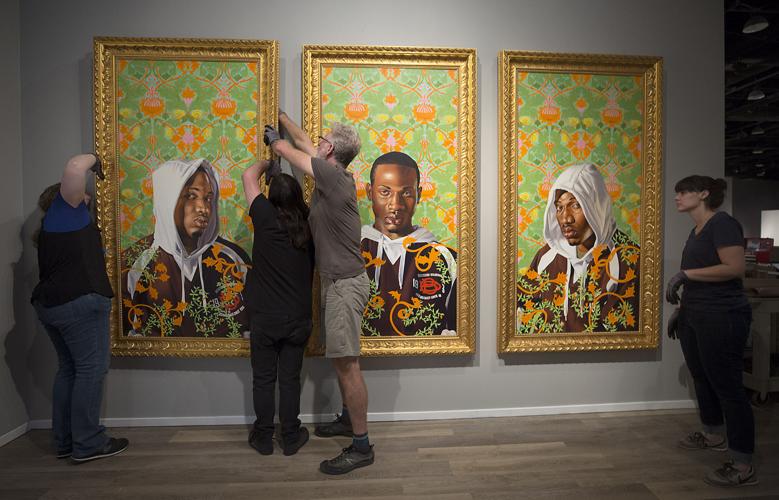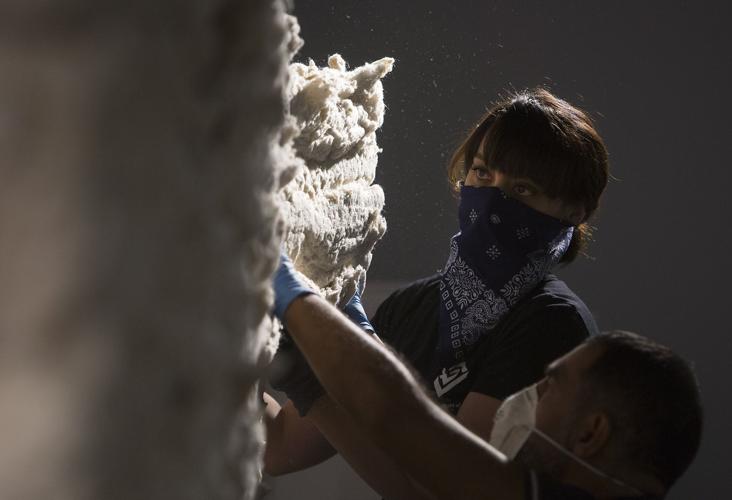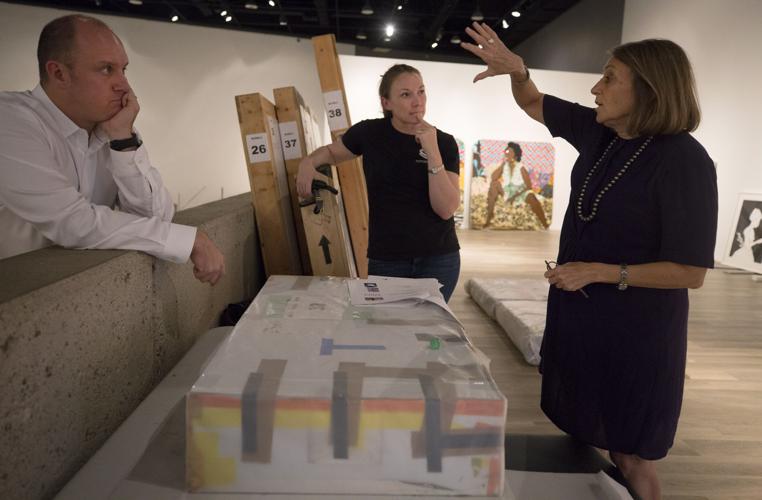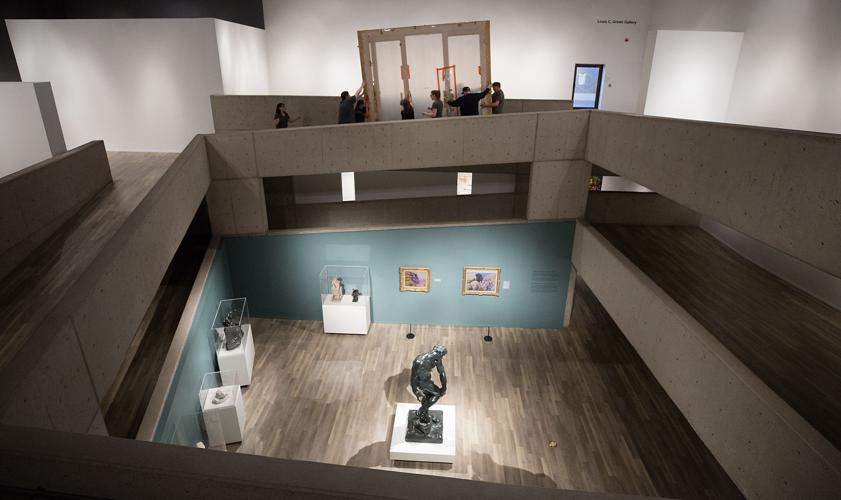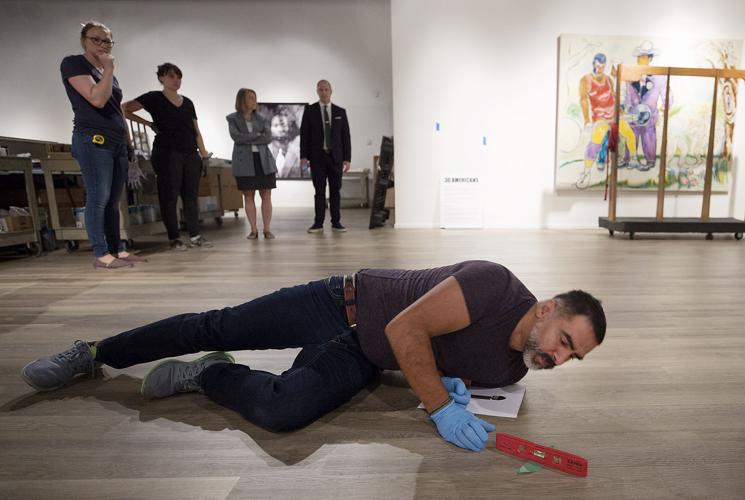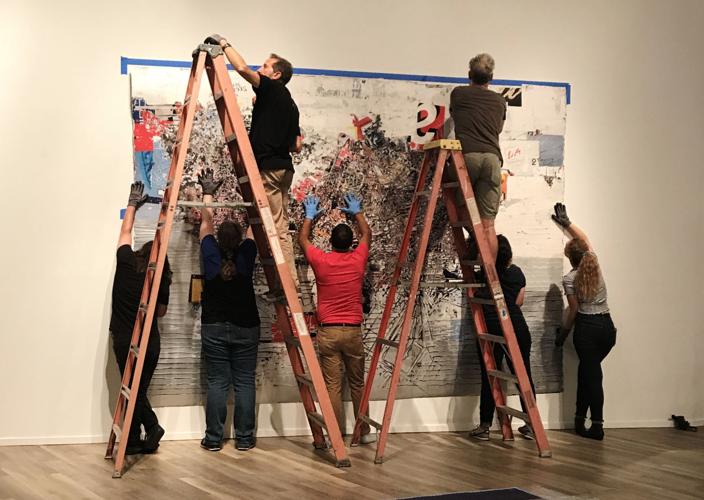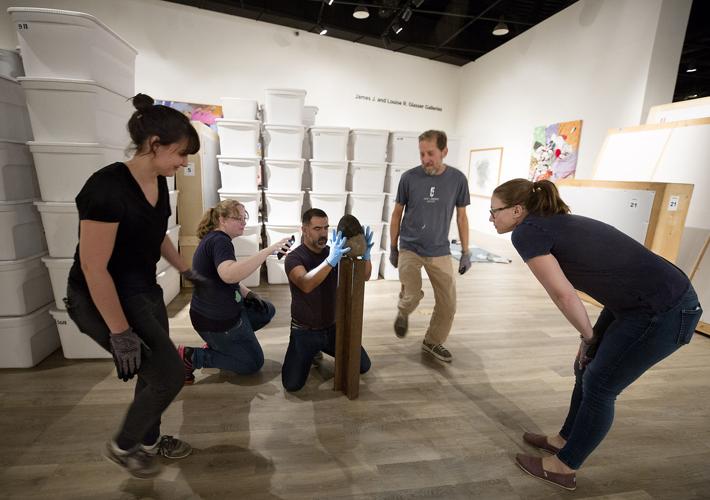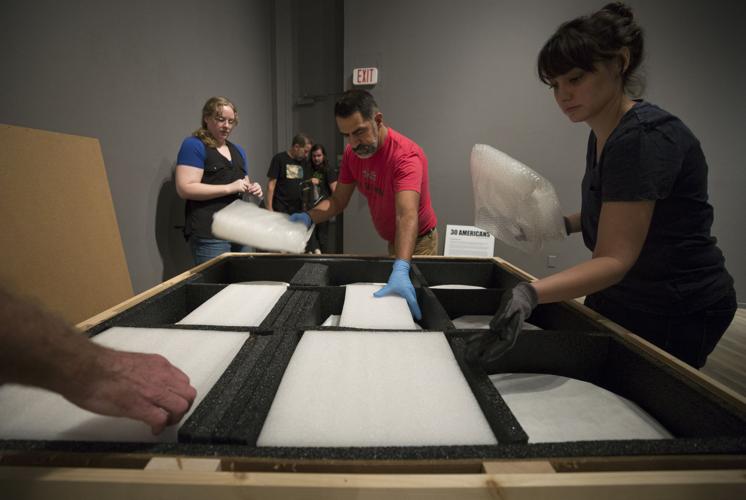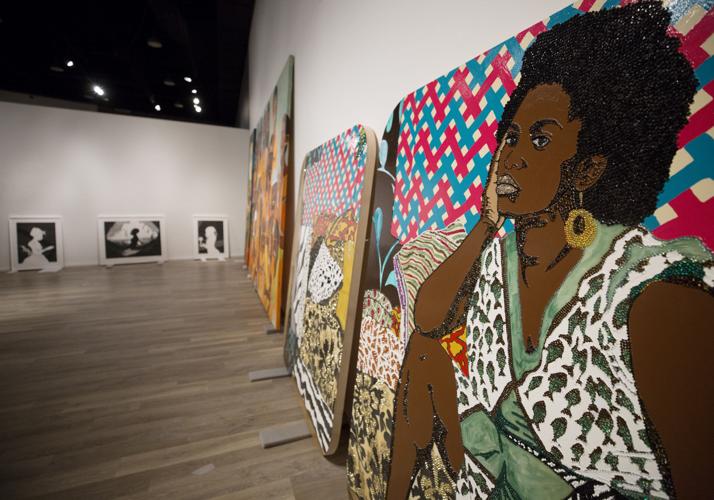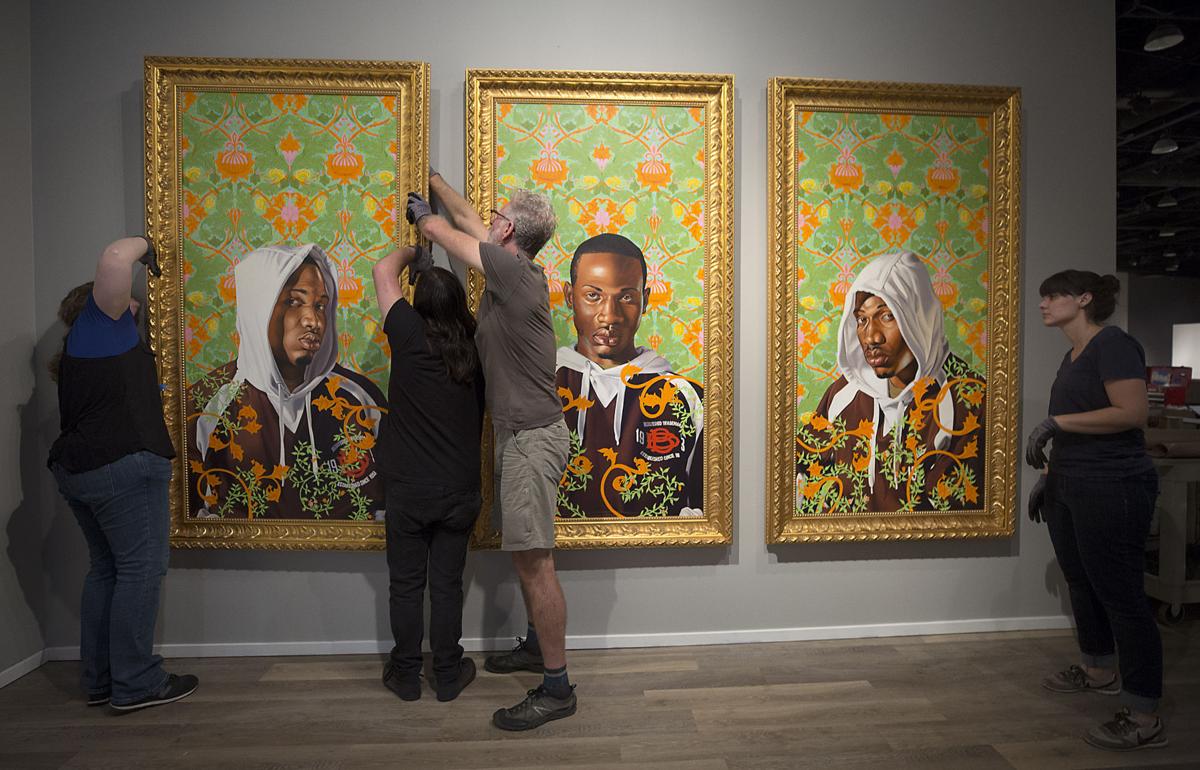It takes six people to get the purple, orange, red, brown, blue and green hair on the mannequin.
The hair cascades down over a pair of brown, black and white leggings until only the feet are showing.
Gigantic colorful paintings leaning against blank white walls serve as a backdrop, as William Vargas and Tucson Museum of Art staff finish installing an art piece by Nick Cave.

William Vargas, collection manager for the Rubell Foundation brushes the hair of a piece by Nick Cave for the 30 Americans exhibit at Tucson Museum of Art.
Vargas, the collections manager for the Rubell Family Collection, grabs a brush and meticulously smooths out the hair, making sure there's separation between the arms and the body and that each hair is in place.
He steps back to check the installation against an image on his iPad.
"It looks nice," he says.
Vargas and the crew at Tucson Museum of Art, 140 N. Main Ave., are setting up a new, highly regarded show, 30 Americans, which opens Oct. 5.
The exhibit features the works of 30 African American contemporary artists.
The Rubell Family Collection was established in 1964 by Mera and Don Rubell and is now one of the world's largest, privately owned, publicly accessible contemporary art collections.
The pieces in the collection have been on the radar of Julie Sasse, the museum's chief curator and the museum's director, Jeremy Mikolajaczak, for years but exhibits like this don't just happen over night.
From the conception of an idea to opening night, the process takes a long time — the 30 Americans show has been in the works for the Tucson Museum of Art since the spring of last year.
There's publicity; grant writing; logistics; coordinating staff to do the installation; writing essays and editorial information; getting to know all of the artists' work and what it represents; and more.
Through all that, a curator's brain doesn't stop working. Sasse is always thinking of the next show ... and the next — or the one that may or may not happen in ten years. That's the life of a curator.
Since starting in the business, Sasse says she has curated hundreds and hundreds of exhibits.

Tucson Museum of Art CEO Jeremy M. Mikolajczak, far left, and Rachel Adler listen to Julie Sasse, the museum's chief curator, as she talks about how pieces from the "30 Americans" show should hang. The show opened Oct. 5.
"It's like a never-ending looking, looking, looking," Sasse says. "Any time I'm on vacation or business trip I'm going to galleries. I'm going to museums. I'm going to check out artist’s studios if I can ... coming up with ideas."
When Sasse pitches a concept for a show, she has to have a narrative on what the show is about, who the artists are and what they represent.
She knows what's in the museum's 8,000 piece collection. She knows what other museums are exhibiting. She follows contemporary artists. She knows what's trending.
A typical day for Sasse can consist of anything from giving lectures to interviewing artists, writing text and planning exhibits. Her desk is covered with stacks of papers and notes. You won't find a blank space on her calendar.
"Right now I'm working on maybe six exhibitions," Sasse says. "Some are far out. Some are immediate. Every piece of paper on this desk is a project of some kind so I can't come away from a meeting without piles of these kind of things, notes after notes after notes and it all means something has to get done. So if anybody thinks a curator is just sitting there doing dusty library doing research it's not true."
During all of the planning, Sasse rarely gets to spend actual time with the art. Instead, she's researching online, getting data about the pieces and the artists. So, when it's time to see the work in person, it's magic.
"When you’re seeing the work or when the truck gets here with all of the images we’ve seen in the books we’ve read, it suddenly gets back to what its about — the object and the maker of that object," Sasse says.
Curating an exhibit is a huge job. But, it's not the whole story. From there, it takes teams of people from registrars, to museum staff and contracted workers to prepare for opening night.
As an artist myself, I've always wanted to see what it's like behind the scenes at the art museum. So I, along with Arizona Daily Star photographer Mamta Popat, spent a few days at the museum during the installation of 30 Americans. Here's a glimpse of what goes on behind the scenes.
Thursday, Sept. 20

Rachel Adler, a collections manager and registrar at the Tucson Museum of Art, holds a crate list as she oversees 40 pieces of artwork being unloaded on September 20, 2018. The artwork was brought directly from Miami and was kept in a trailer at 70 degrees.
Today the truck arrives at the museum. The excitement is tangible. Mamta and I have butterflies.
Every docent or museum employee walking into work mentions how exciting today is. Rachel Adler and Katie Jones-Weinert, the museum's registrars — in charge of the logistics of installing the show — are visibly amped.
It's pretty uncommon for the Tucson Museum of Art to receive an entire exhibit in one truck since pieces usually come from different locations.
This one came directly from the Rubell collection in Florida by way of a giant climate controlled 18 wheeler truck. This thing was massive and FULL. The trailer was kept at 70 degrees, says Steve Patterson, driver for Displays Line Haul Division.
When I first arrived, eight people were carrying an enormous ornate gold frame from the truck into the museum — it's maybe 12-feet by 12-feet. I found out later this frame was for a piece by Kehinde Wiley. If you don't know that name, he's the artist who painted former president Barack Obama for the National Portrait Gallery.

The frame for Kehinde Wiley's "Equestrian Portrait of the Count Duke Olivares" is carefully brought down a ramp and into the Tucson Museum of Art space during unloading on September 20, 2018. 30 Americans showcases works by African American artists of the past forty years.
Adler checks each item with her crate list as it comes off the truck to make sure every piece is accounted for. That includes 126 plastic tubs full of cotton bales for an installation by Leonardo Drew and a number of wooden crates, boxes and other items.
Each piece is removed from the truck very carefully. Packages are labeled with areas you can't put pressure on and each package is carried slowly — often by more than one employee.
"When you're walking down that ramp, will you walk in front of it," Adler instructs a staff member wheeling a crate into the museum.
Inside the museum, the gallery walls are white and empty, like a blank canvas awaiting a painter's brush.
Brown butcher paper sits outside the door with sketched layouts of where each piece will go.

Nicholas Castor, middle, takes great care as he and Percivale Porter, right, slowly roll pieces from the Rubell Family Collection into the Tucson Museum of Art on September 20, 2018.
Each crate is placed in its assigned spot, where it will stay unopened and untouched until Monday so the art can get used to its new space.
"It's coming from Miami so we want the art to acclimate to our environment before we open it," Jones-Weinert says.
Tuesday, Sept. 25

Katie Jones-Weinent helps William Vargas, collection manager with the Rubell Family Collection, place a bale of cotton as part of the installation of Leonardo Drew's "Untitled #25" a piece which features stacked cotton bales at the Tucson Museum of Art on September 25, 2018.
When I arrive today, many of the crates are already opened and paintings are leaning against the walls. When you're an art nerd, seeing pieces like this is such a thrilling experience. Kind of like opening a present with beautiful wrapping.
I stop and stare at "Class of 2007" by Nina Chanel Abney. Mamta and I chat about some of the things we notice in the painting. (I won't go into that here, so you can see for yourself.)
In the Glasser Gallery space, six workers wearing rubber gloves and masks are unpacking and installing "Untitled #25" by Leonardo Drew — a wall built out of cotton bales.
It's fascinating to watch how well everyone works together and how specific everything has to be.
Staff members make sure each bale is placed exactly — even and symmetrical. There are two rows — each one is nine bales high and seven wide — and they all have to fit within the painters-tape boundaries on the floor.
Sasse and Mikolajaczak walk into the gallery to make sure everything is going well. Sasse gets a little nervous when she sees the cotton bales. They look like they might tip over.

William Vargas, collection manager with the Rubell Family Collection, oversees the installation of Leonardo Drew's "Untitled #25" which features cotton bales stacked in a particular order at the Tucson Museum of Art on September 25, 2018.
"We're gonna have to make sure the guards are extra diligent around this one," she says.
The cotton-bale installation alone has taken 2½ hours.
"Is this the end?" Jones-Weinert asks as she places the last cotton bale on top.
"I can't say I've ever stacked up bales of cotton," says Marvin Shaver, an art installer contracted out by the museum.
Potential disaster: the cotton wall only measures 32 inches wide and it's supposed to be 33, so Vargas has to make a phone call to get approval from the Rubell foundation.
Luckily, it's fine.
"Every detail counts," Vargas says as he fills in holes with remaining cotton. "In New Orleans we had to do it two times."
Vargas spends quite a while gluing cotton in cracks and shaping it just right, making it perfect.
Vargas travels to install shows for the Rubell Family Collection so he knows exactly how each piece should look and how to get it to look that way. Adler is thankful to have him around.
"You get to know the pieces intimately (when you travel with them)," Adler says. "It's almost like little personalities. Some pieces have quirks, so it's helpful to have someone like William who knows the quirks."
On a table off to the side, a binder is open to a page with a print of one of the paintings in the exhibit. It's marked with circles and lines and says things like "hairline crack, paint loss, indent, smudges" and other conditions. The staff checks each piece against the list in the binder to make sure nothing has changed.
Meanwhile, Sasse and Mikolajaczak walk through to check on the planned layout.

"Baby I Am Ready Now," by Mickalene Thomas, right, sits against the wall with other artworks ready to be hung at the Tucson Museum of Art on September 25, 2018. The 30 Americans show opens on Oct. 5. The show features 40 works by African American artists from the Rubell Family Collection out of Miami.
There's some disagreement about how some of the pieces are laid out. It's not as simple as just moving them to another area because the show is divided into categories. The challenge is to create a good flow with enough space while working with the nuances of the museum walls, like the angle of the ramp and the fire alarm.
The tension is palpable as the crew moves pieces around and are then instructed to move them again.
"I'd rather have this all day before we hang because once we hang, we don't want to move," Adler says.
After three iterations, they decide on a final plan.
Wednesday, Sept. 26

Katie Jones-Weinent, far right, helps William Vargas, collection manager with the Rubell Family Collection, center, unpack an installation piece called “Duck, Duck, Noose” by Gary Simmons at the Tucson Museum of Art on September 26, 2018.
Today when I walk in more pieces are on the wall including a work by Jean-Michel Basquiat, known for his neo-expressionist paintings and graffiti art. Everyone I talk to at the museum (myself included) is excited about this one.
In the Contemporary Art Society gallery space, the crew gets ready to unpack Mark Bradford's piece, "Whore in the Church House."
This one is rolled onto a giant tube and covered in plastic.
"So, we're gonna roll it out?" Jones-Weinert asks Vargas.
"Yeah and we need four blankets to go underneath," Vargas says as he cleans the area . "It'll be face down when unrolled and then we measure and tape the wall and hang it up."
Vargas removes his shoes, steps on the blankets and slowly begins to unroll the piece, making sure the blankets stay smooth and the plastic is just right.
Art installers Marvin Shaver and Dave Brown measure the wall and place blue tape where the painting will go.
"It's too tall," Vargas says. "It needs to go down."

Tucson Museum of Art staff and professional installers hang Mark Bradford's piece titled "Whore in the Church House" for the 30 Americans exhibit.
They move it down and add a strip of tape on the wall where the top of the piece will go.
Vargas and four other people lift the piece together.
"As fast as possible, push it against the wall," Vargas says.
Shaver and Brown wait on ladders so they can get the top of the canvas.
"William, you wanna go look at it while it's being held?" Brown asks.
Vargas steps away and gives them the OK before they start hammering pins into the top of the canvas.
Thursday, Sept. 27

William Vargas, collection manager with the Rubell Family Collection, uses a level to find the flattest part of the TMA floor before installing a sculpture by David Hammons.

Tucson Museum of Art staff stomp the floor as William Vargas holds the sculpture "Esquire" by David Hammons to test its stability.
Today when the crew walks in around 9 a.m., they're tired.
"It's a marathon," Adler says. "We're into Week 2 and we still have next week."
By now, most pieces have been unpacked and some have been installed. There are quite a few works that still need to go up.
Crates lean against the walls and stacks of empty white bins litter the space. There are enough bins and crates to fill a house. It literally looks like someone just moved. All the packing materials need to go into storage until the show is over in January.
Vinyl signage needs to be applied to the walls and and paint needs to be touched up. The lighting needs to be adjusted.
That'll all happen early next week so the show is ready to open with a community celebration Oct. 5.
Sasse can't wait to see how the show is received and says there hasn't really been a significant focus on African American art in Tucson.
"I think often times we in Arizona look at 'what percentage of African Americans do we have here? And the percentage is so small let's not address that,' but we’re part of a bigger world and we’re part of a bigger art world," Sasse says.
If you go
What: 30 Americans Art Exhibit
When: Oct. 5 through Jan. 13
Where: Tucson Museum of Art, 140 N. Main Ave.
Cost: $12 adults and free for children 12 and under
Info: A free community celebration will take place Oct. 5 from 7-9 p.m. Go here for more details.


